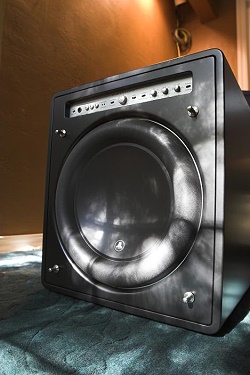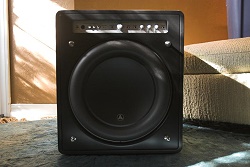Introduction
This article is, in many ways, a departure for me. For one thing, it is WAY, WAY late. I’m usually pretty conscientious about these things. I mean, of course, I procrastinate, but when push comes to shove, I usually shove on through, get wheels on the wagon and roll. Not this time. Life doesn’t wait for good audio. I had a few personal events that cascaded into an avalanche, and I pretty much crumbled. Suffice to say, some things just don’t end up going well, and you’ve got to leave it at that.
Fortunately, some things go splendidly, unbelievably so, and while I wouldn’t assign single-handed credit to JL Audio for rescuing me from my personal mire, the subjects of this article, the Fathom f112 subwoofers, did in fact perform a supporting role in what I’d call musical therapy, and their sheer demonstration of what can be done when things go very, very well, is just plain inspiring.
Let me back up, a lot.
A friend has quoted to me, from a self-help book, that ‘timing is perfect.’ Hardships often open up opportunities. In a strange parallel example, while a company whose products I admired was quietly going out of business, absent from the 2006 CEDIA show, Captain Purple (known to insiders as Barry Ober, Industry Know Guy) suggested I check out something new in home audio, JL Audio.
Specifications
- Design: Sealed Enclosure
- Driver: 12″
- Amplifier: 1,500 Watts RMS
- MFR: 19 Hz – 150 Hz, – 3 dB
- Dimensions: 18.5″ H x 15″ W x 17.8″ D
- Weight: 115 Pounds
- MSRP: $2,700 USA
- JL Audio
JL Audio isn’t a new company. I had become familiar with their car audio subwoofers, capable of smooth, clean bass with minimal enclosure volume, enabled by the delicate application of raw muscle & sinew. A friend had a Chevy Camaro outfitted with a single 10″ JL Audio subwoofer that provided the highest-quality low frequency production I’ve heard in an automobile, particularly impressive since the whole system was virtually invisible. There were no carpet-covered enclosures, exposed amplifiers, etc. The impressive feat on the subwoofer’s part was that it was doing its job with less than a single cubic foot of enclosure volume, and doing it well. As a hardcore audiophile, I was surprised, and impressed.
But still, on the whole, home audio seems like a very different market. Competition car audio is known best for absolutely ridiculous SPL, not sound quality. If it weren’t Captain Purple himself (Barry) telling me that I should be watching out for the new neighbors on the block, I might have been quite dismissive. Even so, I remained a wee bit skeptical. Besides, I had become a bit worn out with claims of anything new and improved. I had already discovered combinations of certain products that I found, when carefully set up, that provided me so much of what I wanted in music and theater audio, that despite a whole lot of listening to other systems, I had not turned up anything substantially superior in my estimation. In other words, I had become bored with the idea of looking at new equipment. For an equipment reviewer, it’s kind of depressing.
JL Audio’s demo, using an array of subwoofers and prototype ‘satellite’ speakers cleared my mind, shook loose my inner doubt, and once more ignited a fire in my belly for something new. This was not the car audio sound I passed on the state highway- some poor kid destroying the hair cells in his inner ear with razor-sharp treble and providing nausea for me with poorly tuned, ultra-resonant bass. JL Audio’s demo not only brought dynamics and ease at listening levels that would have made almost every other home audio system sputter and hack up a lung, it did so with a comfortable, sweet, balanced, neutral finesse that simply spelled beauty out in a soundstage. This was real fidelity! That wasn’t the verbiage that crossed my mind immediately. I believe it was, rather, “What the $%^&?”. I simply was not prepared, despite Barry’s warning.
After the demo, I had a chance to talk shop with Carl Kennedy, one of Barry’s friends and former coworker. Carl had joined JL Audio to help develop their home audio division, with the support of the company’s brass and engineering talent behind him. Interestingly, Carl had previously worked at the company who then made the loudspeaker products I had become so fond of, as the head engineer. He went to JL Audio, explicitly because they offered to let him take home loudspeaker design even farther, without constraints. The f112 subwoofers are members of that first round of expression, sandwiched in the subwoofer product line between the f110 and f113. Later, the Gotham followed, a downright beautiful monster, and I’m just freaking out in a proverbial itch waiting for those ‘satellite’ speakers to come to market.
It would be very interesting to relate the subsequent volley of audio trivia, technical banter, and recording industry anecdotes that passed between Captain Purple and Carl as they answered each of my questions with a machine gun spray of information, often steering off on wicked tangents about aerospace laboratories and lubricants, the nature of human perception, and the meaning of life without odd-ordered harmonics, and how that eventually spawned Carl Kennedy’s awesome blog, which I urge EVERYBODY to read for their own benefit but . . . .
Now, Specifically About the Fathom, f112 Subwoofers
They are fantastic. That’s more or less what I’ve got to say, but in the interest of seeming a bit more thoughtful about the subject, I’ll elaborate.
What are they, exactly? I can’t answer that in a nutshell. Not if you want more specific than fantastic. The condensed version is that they are relatively small, insanely well-built, extremely powerful, very smooth, tight, detailed to a fine line, clean, poise-laden, dynamically proficient, utterly kick-ass subwoofers.
For the less condensed version, let us proceed.
They arrived in style, amply packed, each safely enclosed. The shipping/receiving outlet I used was anxious to have me pick them up. I was anxious as well.
Leroy, the Great Pyrenese guard dog, checked them out, and promptly cleared them through the security checkpoint.
When it came to unpacking, there was a well-documented…. ‘procedure’ to be followed.
The subwoofers came supplied with gloves, for unpacking the subwoofers, of course. The finish is nice, and the subwoofers are heavy, so the gloves were a nice accessory.
 |
 |
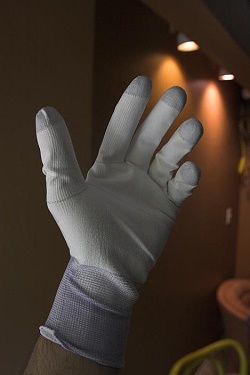 |
The unpacking process involves opening the top of the box, turning the box upside down, and lifting the box up. The subwoofers are packed upside down to facilitate this method.
I liked the cool plastic donuts on the box. Not only do they keep the box off the ground, away from any potential moisture in your garage/kitchen/whatever, but you can also recycle them as dog chews, if you actually get rid of the boxes (but generally it’s a good idea to keep them for awhile, for any possible shipping needs).
After turning over the box and lifting it off the subwoofer, you are left with a cloth-covered subwoofer on two foam pieces. You simply rock the subwoofer onto one foam piece, remove the loose piece of foam, rock it back onto the ground, and remove the remaining foom. Then remove the cloth, and BAM. Out of the box beauty!
The front is nice and clean, but has all the controls necessary for dialing in the subwoofer(s) with the rest of the system.
Front panel controls include
• A power switch – This can be set to Off, On, or Auto. I don’t use Auto, on any subwoofer. Subwoofers only get sent, by virtue of their job description, the lowest frequencies. As a result, they won’t wake up until some significant amount of bass makes it into the soundtrack. During the time of that transition between Standby to On, they don’t reproduce that low bass. A good implementation will minimize the turn on delay, and not turn off before you’re done listening to whatever. The JL Audio implementation is thoughtful, with a 30 minute turn off period (after 30 minutes without audio to the subwoofer, the unit will turn off), and Carl’s blog site goes into ways to optimize the operation of auto-turn-on systems. But, I don’t think the mild energy savings really makes this feature worth much, and as Carl points out, many electronics actually last longer if you simply avoid power cycling and leave them on. But it’s there if you want it. I set the switch to On, and just left it there.
• Automatic Room Optimization – When used with the supplied microphone (plugged into the microphone input), these controls allow you to set up the room correction system, which applies EQ to compensate for response anomalies relating to the interaction of the subwoofer location and the room itself. This isn’t as comprehensive as some of the room correction systems that make measurements at multiple locations, and then applies a weighted curve, but it can really be handy if you’ve got a nasty peak that distracts from the musical or theatrical content, long after the novelty of the ‘ultra shake’ at that frequency wears off. There’s an input for a calibrated microphone, a Demo button (which would seem useless to the end user), a Defeat button, which lets you bypass the correction, and a Calibrate button, which lets you start the whole procedure.
In reference to the Demo button though, here is what Carl Kennedy, of JL Audio, had to say: “The demo button serves many valuable purposes. For the installer it can be helpful to test-position the sub in various locations while using the demo button to listen for octave-to-octave performance “in room” without setting up a source. It is a good place to start when trying to figure out why your sub may not be playing allowing you to rule in or out a dead sub and direct your attention efficiently toward wiring or settings. It is a good way to confirm that master/slave is set and wired correctly prior to having a preamp and player connected. Lastly and most importantly it is a priceless tool when discussing tech issues over the phone. By talking the installer or consumer through a variety of settings on the phone we can both evaluate and troubleshoot a sub’s operation and even educate a consumer on what they are hearing using these specific tones.”
I need to applaud the implementation of the Automatic into the ARO. The Infinity Beta 10″ subwoofers I had previously reviewed some time back also had a room correction notch filter, but the automated calibration process was far easier with the JL audio. Set up the microphone, press the button, and it emits a series of tones first to allow you to set a level loud enough to really get a good signal to noise ratio, but not so loud as to overload the subwoofer into distortion. Once it’s satisfied that we’ve set the volume via the master level to correct levels for the test, it does a slow sweep over its operating range, applies a correction filter, and it’s done. It really is very easy. No playing tones and plotting the response and then adjusting a variation of a slide ruler to derive settings. Bypass the subwoofer controls, press one button, maybe apply a couple knob turns to set the test level, reset the controls, and fine tune the settings. The actual correction process is done within minutes. In the case of multiple subwoofers, you can either do a correction for each subwoofer individually (for instance, if you’re running them in stereo), or you can connect one subwoofer through the ‘master’, using a cable from the master’s output to a special input, and have a single filter applied to the summed subwoofer response.
After getting both subs in good room positions, that needed no obvious correction across a wide listening area, between correcting the room response of each subwoofer at a single location and simply defeating the correction, I preferred not using the room optimization. It did sound tighter, but also had a little less body. I wondered at first if a flat response just lacked the peaks that add a superficial punch, but compared to headphone listening, there was a bit missing. I suspect that my particular room acoustics, which simply do not work, at all, with a single subwoofer location, anywhere, may have something to do with individual correction not carrying the day. I will try out the latter method, using a master and slave setup, where one microphone and filter compensate for the summed response of both subwoofers, and report results as I have them. Regardless, it’s a cool, easy feature that will most often come in handy, and if it doesn’t, you don’t have to leave it engaged. One thing that did bug me, though was that if the subwoofer loses power, upon power up, it turns off the Defeat option. I’d prefer that it remembers my last settings. Minor thing.
• Master/Slave indicator – This simply indicates whether the subwoofer is configured as a master (who dictates how the signal is driven through level/crossover/correction adjustments) or a slave (who takes the signal as dictated by the master). You actually set this on the back of the subwoofer, but if you’re trouble-shooting, it’s nice to know on the front panel, and you simply get another set of cool LED lights.
• Volume control – There is both a Ref/Variable switch, that lets you set the gain to a fixed level with Ref, or a variable level with Variable, as well as a knob that allows the user to adjust that variable again with the Master Level.
• Light control – No, not the room lights, smarty pants. Front LED display brightness. There’s High, Low, and Off, to suit most any occasion.
• Low pass filter slope control – Options are Off, (used if you’ve got an outboard crossover, or your preamplifier is performing that function) 12 dB, and 24 dB (per octave).
• Low pass filter frequency control – Allows setting the cutoff point for rejecting higher frequencies from 30 Hz to 130 Hz.
• E.L.F. trim, -12 dB to +3 dB – This is essentially an adjustable EQ for the very lowest frequencies, primarily to allow a user to adjust the very bottom of the subwoofer response to compliment the amount of room gain, most often so that you won’t have to put up with the infrasonic exaggeration resulting from subwoofers with very deep bass response put into rooms that emphasize the same.
• Variable phase control from 0-280 degrees – Used to match the phase of the subwoofer to the main speaker(s) it compliments. The most direct way of setting this is to play a tone at the crossover point, and adjust phase until it’s loudest, at which point the waveforms will be in phase.
• Polarity switch – 0 or 180 degrees, often otherwise labeled as Positive and Negative Polarity.
Altogether we’ve got all the basics on the front panel for fine tuning the response of the subwoofer(s). Many users will never touch these controls, but rather perform the respective functions in their preamplifier/controller units, but it’s really handy do have them, and darn it, those knobs are just plain pretty, and options are always good!
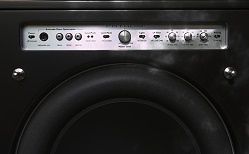 |
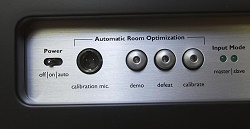 |
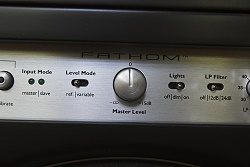 |
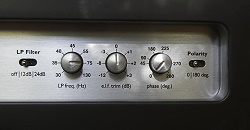 |
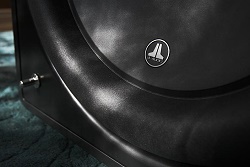 |
A quick look at the Fathom f112’s rear shows sheer, elegant, utility. The back plate itself is a heat sink, with a sparse collection of connections and a couple switches.
There are two pairs of audio inputs, both XLR balanced and RCA unbalanced. The RCA unbalanced inputs happen to be opto-isolated (isolated via an optical conversion, to eliminate the possibility of ground loop). There is also an XLR output to other Slave subwoofers, and a switch that designated the operation of the subwoofer as either a Master or Slave (we’ll get into this later). In addition to a switch that allows you to either ground or float the audio ground in relation to the power ground (one more tool to fight potential hum), there’s an IEC power socket.
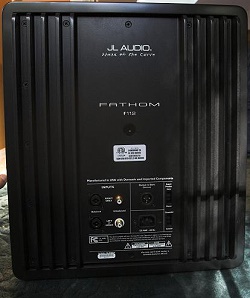 |
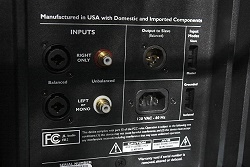 |
Let’s get to it.
The Fathom f112 subwoofer is a freaking rock of build quality, evidenced not only in finish, and the fit of components, but sheer weight, most of which resides in the absolutely massive motor assembly of the driver. With heaps of switching amplifier power and lots of power handling, the subwoofer doesn’t require a whole lot of enclosure volume to get deep, prodigious bass. It’s not the smallest subwoofer, to be sure, but for its low frequency output capabilities, particularly with a simple sealed system, the unit is downright tiny. Tiny, but not light. Between carrying them up the stairs, unpacking, and moving these things around for optimal room location, I just about broke myself. If you take these things home, don’t let pride break you. Bring a friend, and better yet, a piano dolly with that willing companion. Got stairs? Good luck. And by the way, I keep saying subwoofer(s) because I got two of them for this review.
Something I found really interesting was the fact that the Fathom “12 inch” driver, unlike most other drivers actually was a whole 12″ from edge to edge of the surround. This shouldn’t be atypical, but it is. Most drivers called 12″ in diameters, are 12″, sort of, but not if you only include the parts that actually push air. Many just have a 12″ frame, and the cone/surround are actually substantially smaller. Now, as most DIY bass enthusiasts will tell you, you don’t count edge to edge if you want to calculate the radiating area, but rather from the middle of the surround on one side to the middle of the surround on the other side. The surrounds on the Fathom f112 drivers are big and fat to accommodate long excursions, so the radiating area, for the sake of doing displacement calculations, has a diameter of roughly 10.5″. Still, that doesn’t negate the fact that this is a beefy 12″ driver, with a real 12″, and when combined with the massively long throw, more potent, in terms of displacement, bigger than every other I’ve seen claim the 12″ specification.
This machine isn’t just pretty on the outside. While I liked that the driver extends the surround to the actual edge of the frame of the basket, hiding anything ugly, it’s also pretty on the inside. The motor structure if just plain massive, giving you plenty of power handling (and inversely less power compression), and the switching power amplifier section makes full use of that capacity. I couldn’t figure out an easy way to remove the driver to take a look at it, and having seen how difficult it is to maneuver a driver that heavy, didn’t want to really find out. Instead, I show you this image from our 2006 CEDIA show report, detailing the driver assembly (photo below). The driver sports over 2″ peak to peak linear excursion, with 4″ peak to peak total excursion.
The amplifier and driver are matched, both in terms of power output, and impedance, providing some really ridiculous low frequency output capabilities for a single driver subwoofer of this physical size.
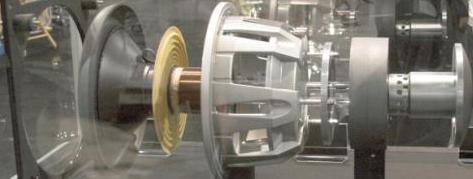
So, yeah, it’s technically impressive.
The bread and butter question though, is how does it sound? I think I’ve hinted at that, previously, but let me clarify.
The Fathom f112s sound AWESOME!
By that I mean . . . .
As Arny Krueger has said, “A perfect loudspeaker is an oxymoron”. Some compromise is inherent in anything. Every loudspeaker system, of any type (especially those highly polished $250,000/pr monoliths), have weaknesses. The art of and science of loudspeaker design is to balance, work around, and avoid compromise within the constraints of size, budget, and physics, to achieve the best performance within a set of target goals. In my opinion, the JL Audio Fathom f112 is one of the most elegant expressions of combining art, engineering, and just plain sense in the a price range that, while not cheap, is entirely within the range of mortal budgets. Not everybody’s budget, but a brand new f112 still costs less than a reasonably good used motorcycle. For the cost of a pair, you could buy a fairly decent new motorcycle. Still, for somebody who loves audio, I’d consider the a pair of Fathom f112 subwoofers a far greater value.
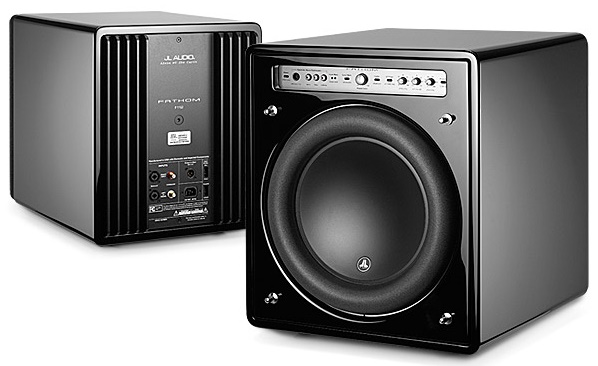
I believe that if an audio system can’t do music well, it can’t really do theater audio. And, if it can’t do the dynamics of theater, it’s dead in the water for music. Sound is sound, by definition. Music is in movies. Voices are in music. Percussion is in both. It’s just a fact. If a person has a preference/tolerance for certain colorations under different playback scenarios, that’s their right. But, for me, if it can’t do both well, it doesn’t do either well.
I really like films, and am absolutely spoiled by good video, but when it comes to being critical, I am a music lover first. It is in the context of listening to music that I REALLY pay attention to the audio, because that’s the only thing of consequence. Rendering music, the Fathom f112s did so absolutely wonderfully, and I just plain fell in love.
Specifically . . . .
Tori Amos, Sweet The String – The Fathoms had great definition on bass guitar transients, complimented by even tone, solid body, but not fat, filled out the bottom of the S-150p satellite speakers with superb integration. Blending a ‘real’ 12″ woofer with a 5″ midbass? Not a problem.
Tori Amos, Ireland – The entire range, top to bottom, formed a unified soundfield. Bass guitar was quick on the plucks, meandering up and down the range, clearly. What is “Speed” with bass? Strictly speaking, it’s well-damped, and smooth in response. In this track, it was tight, and extremely coherent, flying an easy, effortless cruise, ending with a volley of shuddering organ bottom notes, and eerie envelopment.
Ben Harper, Burn One Down – The apparent transient velocity with drums, kick drum, allowed me to easily hear the impact itself, with no observed overhang. Percussion just SMACKS!
Chris Issac, Baby Did a Bad, Bad Thing – The opening shudder went through the walls, the floor, my gut, but wasn’t distracting or out of place, serving the music.
Primus, Have a Cigar – During this Pink Floyd cover, Les Claypools percussive bass, with slapping drums, is delicate and violent in detail. The recording is raw, and not at all what I’d call ‘audiophile’, but the music is good just the same, and each bass note was clearly defined in space, transient attack, decay, and stopped in place. The soft wail of the lead guitar came through unobstructed by the controlled frenzy of the bass guitar, or the insistence of cymbals, kick, or snare drums.
Nirvana, Where Did You Sleep Last Night (MTV Unplugged) – This was interesting, with an acoustic, real-space character of reverb. The benefit of the subwoofers was not only the rendition of the instruments themselves, but also in revealing the recording itself, pumping the room. The Fathoms helped me feel more like I was just there.
Peter Gabriel, Kiss That Frog – Peter Gabriel loves the low end. This track provided it, deep and satisfying, with a throb of electric bass surges, detailed and powerful. It was absolutely room quaking, while still subtle and poised. Oxymoron? Nah, just remarkable.
Jane’s Addiction, Ted Just Admit it – I can’t listen to the entire song, but the opening, with the kick drum hits, clean and solid, really do it for me with a good bass system. The JL Audio Fathoms didn’t let me down, at all.
Emmylou Harris, Red Dirt Girl (Bonnaroo) – The driving kick drum with the ‘Live’ concert sound. Reverberant, but unbooming, with the occasional epic electric bass shudder, solid rocking, detailed dalliance, large venue bass sound, in my living room. That’s ambiance retrieval.
Can, Last Night Sleep – In this track, there is a textured electronica painted over a synthetic seismic rhythm. It shook, awesomely, without boom or mud, a quick succession of machine gun trembling within what would seem like a single tone with many reproduction devices. Most definitely a WTF kind of moment!
Johnny Cash, Rusty Cage – The Fathoms played beautifully, providing the resonance of Johnny’s chest.
Paul Simon, Diamonds on the Soles of Her Shoes – The intro had a great sense of space, reverberant and majestic. When the song kicked in, the kick drum was easy, natural, and smooth.
Conclusions
So, that’s pretty much it for my observations. How can I summarize best? The JL Audio Fathom f112 subwoofers are awesome, and severely well-rounded. They are my favorites to date, period. Perhaps I should just conclude with my initial reactions, e-mailed to Carl Kennedy after my initial exposure at home. The impressions have held after living with them for months:
“My #%*^ing lord, Carl.
“While I’ve never had the pleasure of TWO MX-5000 mkII’s for comparison . . . .
“This is way better than sliced Montery Jack cheese with a bottle of good wine and a wicked beef stew.
“With the right music, I’m alone in the house in a cold sweat, giggling like a little freaking girl. I get definition, depth, and dynamics fit for a sloppy wet dream. I’m hearing $#^+ in the low stuff I haven’t heard with good headphones.
“I’d really like to call you an @**hole for having such a profound effect on my emotional state, but I think I love you.
“Thanks for stimulating my addiction.
“Seriously, thanks. I haven’t had anything this refreshing from audio equipment since a long, long time. This is the kind of $#^+ that makes me want to believe again.
As sincerely as a junkie can get.



